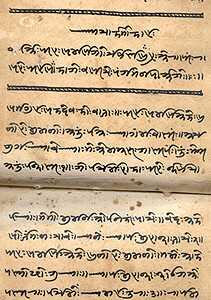Ginans are a vast collection consisting of several hundred compositions which have been a central part of the religious life of the Nizari Ismaili community of the Indian subcontinent that today resides in many countries around the world. Derived from the Sanskrit jnana, meaning contemplative knowledge, Ginans refer to the poetic compositions authored by Ismaili Pirs, who came to the Indian subcontinent as early as the eleventh century to teach the message of Revelation to non-Arabic speaking people.
“Ismaili tradition maintains that from at least the time of the Fatimid empire [909-1171] in Egypt, the Ismaili Imams dispatched their proponents, the da’is, to the Indian subcontinent for the propagation and exposition of Satpanth, the Path of Truth. These da’is sought to summon humankind to a recognition of the spiritual supremacy of the Prophet’s family. This activity continued when the Nizari branch of the Imams moved to the fort of Alamut in 1094 and was maintained even after the Mongol onslaught wiped out this Ismaili state in 1256″ (Asani, Medieval Ismaili History and Thought p 267-8).
The Pirs “were no ordinary missionaries …they were spiritually enlightened individuals whose religious and spiritual authority the Isma’ili Imams had formally endorsed by bestowing on them the title of pir” (Asani, Ecstasy and Enlightenment p 84). One could not become a Pir through inheritance unless he had been so designated by the Imam of the Time. Hence, the Pirs became tangible symbols of the Imam’s authority in South Asia” (Asani, Medieval Ismaili History and Thought p 267-8). “They were second only to the Imam himself in the Ismaili hierarchy” (Virani, “Symphony of Ginans,” Reason and Inspiration in Islam p 502-3). The literature is also shared by the Imamshahi community in Gujarat, who are believed to have split off from the Nizari Ismailis in the sixteenth century (IIS).
Through the poetic medium of ginans, the Pirs provided guidance on a variety of doctrinal, ethical, and mystical themes for the community while also serving to explain the inner (batin) meaning of the Qur’an to the external (zahir) aspects. In his pronouncement, Imam Sultan Muhammad Shah guided the community in this issue: ‘In the ginans which Pir Sadardin has composed for you, he has explained the gist of the Qur’an in the language of Hindustan’ (Asani, Ecstasy and Enlightenment p 30).

A composition titled Moman Chetamni (‘A Warning for the Believers’) depicts the Qur’an as the source of Satpanth:
Eji nur ja parghatiya
tenue vaas chhe nur ja maanhe;
tene aa satpanth pedaa kidhaa
khoji kaadhiyo kuran maanhe; cheto… (v 7)
Light manifested from Light
its abode is in the Light;
He created this true path (satpanth)
and searched it out from the Holy Qur’an.
Eji Ali Nabi thi je satpanth chaliaa
Tene sreviay gupt aapar
Atharvedi aa panth kahiae
Te to khojiya kuran minjar Cheto…. (v. 162).
Satpanth began from Ali and Prophet Muhammad;
follow it more discreetly.
this satpanth is according to Athar Veda (the last Veda [Hindu scriptures])
you can find its proof in the Qur’an.
(Ali Asani, Hymns of Wisdom, McKenna College)
In verse 258 of his composition Man Samjaani, Pir Shams says:
Pir Shams pade ilm Kuran,
Moman so jo jaane bharan ginan.
Pir Shams narrates the knowledge of the Qur’an
A believer is one who knows the divine knowledge (tr. M. Kamaluddin)
In verse 202 of his granth titled Saloko Moto (also termed Vaek Moto), Pir Shams explains:
Satgur kahere Pir Shams kuran ja bhakhiya,
Ane bhakhiya char ved ja jan;
Te gat gangamanhe besi kari,
Kidhi sachi saankh nirvan re…
Pir Shams has preached the Qur’an
and preached the four Vedas;
among the gathered congregation
he has narrated the true signs.
(tr. Ali Asani)

In verse 5 of his Sat maarag Shams Pir, Pir Shams states:
Gur naache garbi maahe
Te gaae kuran ne re lol
The Pir danced to the garbi and
explained the teachings of the Qur’an.
(tr. M Kamaluddin, Ginan Central, University of Saskatchewan)
Pir Sadardin, in his composition Aas punee hum Shah dar paaya says:
Pir Sadardin yaaraa pade re Kuran
Baahaar jaave taaku andar laanaa,
Shah naa sujaano aapnaa pirne pichhaano (v. 6).
Pir Sadardin recites the Qur’an
He brings back into the fold those who leave it.
Know the Imam (in his essence) and recognise your Pir (Guide).
(tr. Ismaili.net).
In another of his composition Aasmani tambal vaajiyaa Pir Sadardin states:
Kal maanhe Mahamad Shaahni vinati; tame bhuli ma jaao ji (v 13)
In the present age Prophet Muhammad pleads: “do not be forgetful.”
Pir Sadardin boliyaa; tame ginaan vichaaro ji (v. 15)
Pir Sadardin has said: “Reflect upon the ginans.”
(tr. Karim Maherali, Ismailimail)
Sources:
Shafique N. Virani, “Symphony of Gnosis,” Reason and Inspiration in Islam Ed. Todd Lawson, I.B. Tauris in association with The Institute of Ismaili Studies, London, 2005 (p 502-521)
Ali Asani, Hymns of Wisdom, Claremont McKenna College ( video: approx. 1 hour 10 minutes)
Ali Asani, The Ginans – Awakening the Soul Through Wisdom (1 hour 15 minutes)
